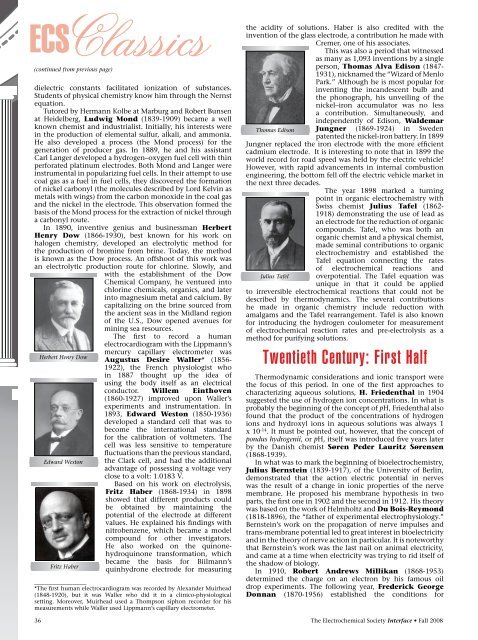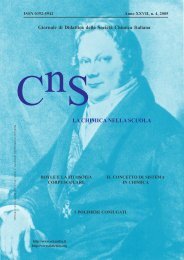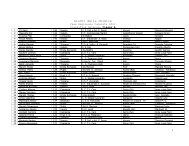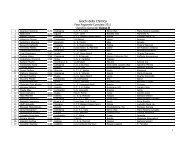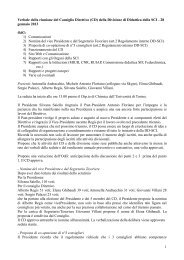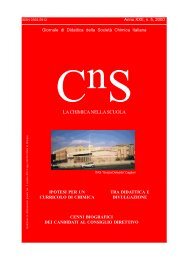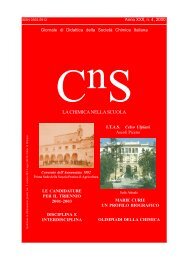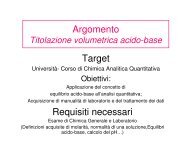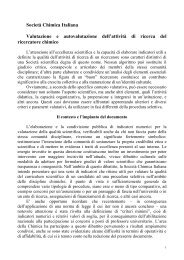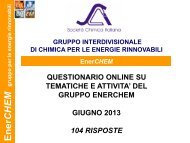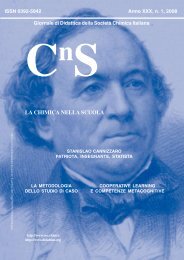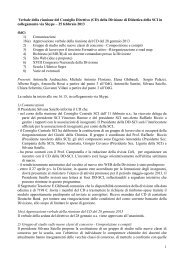ECS Classics - The Electrochemical Society
ECS Classics - The Electrochemical Society
ECS Classics - The Electrochemical Society
Create successful ePaper yourself
Turn your PDF publications into a flip-book with our unique Google optimized e-Paper software.
<strong>ECS</strong> <strong>Classics</strong><br />
(continued from previous page)<br />
dielectric constants facilitated ionization of substances.<br />
Students of physical chemistry know him through the Nernst<br />
equation.<br />
Tutored by Hermann Kolbe at Marburg and Robert Bunsen<br />
at Heidelberg, Ludwig Mond (1839-1909) became a well<br />
known chemist and industrialist. Initially, his interests were<br />
in the production of elemental sulfur, alkali, and ammonia.<br />
He also developed a process (the Mond process) for the<br />
generation of producer gas. In 1889, he and his assistant<br />
Carl Langer developed a hydrogen–oxygen fuel cell with thin<br />
perforated platinum electrodes. Both Mond and Langer were<br />
instrumental in popularizing fuel cells. In their attempt to use<br />
coal gas as a fuel in fuel cells, they discovered the formation<br />
of nickel carbonyl (the molecules described by Lord Kelvin as<br />
metals with wings) from the carbon monoxide in the coal gas<br />
and the nickel in the electrode. This observation formed the<br />
basis of the Mond process for the extraction of nickel through<br />
a carbonyl route.<br />
In 1890, inventive genius and businessman Herbert<br />
Henry Dow (1866-1930), best known for his work on<br />
halogen chemistry, developed an electrolytic method for<br />
the production of bromine from brine. Today, the method<br />
is known as the Dow process. An offshoot of this work was<br />
an electrolytic production route for chlorine. Slowly, and<br />
with the establishment of the Dow<br />
Chemical Company, he ventured into<br />
chlorine chemicals, organics, and later<br />
into magnesium metal and calcium. By<br />
capitalizing on the brine sourced from<br />
the ancient seas in the Midland region<br />
of the U.S., Dow opened avenues for<br />
mining sea resources.<br />
<strong>The</strong> first to record a human<br />
electrocardiogram with the Lippmann’s<br />
mercury capillary electrometer was<br />
Herbert Henry Dow<br />
Augustus Desire Waller* (1856-<br />
1922), the French physiologist who<br />
in 1887 thought up the idea of<br />
using the body itself as an electrical<br />
conductor. Willem Einthoven<br />
(1860-1927) improved upon Waller’s<br />
experiments and instrumentation. In<br />
1893, Edward Weston (1850-1936)<br />
developed a standard cell that was to<br />
become the international standard<br />
for the calibration of voltmeters. <strong>The</strong><br />
cell was less sensitive to temperature<br />
fluctuations than the previous standard,<br />
Edward Weston the Clark cell, and had the additional<br />
advantage of possessing a voltage very<br />
close to a volt: 1.0183 V.<br />
Based on his work on electrolysis,<br />
Fritz Haber (1868-1934) in 1898<br />
showed that different products could<br />
be obtained by maintaining the<br />
potential of the electrode at different<br />
values. He explained his findings with<br />
nitrobenzene, which became a model<br />
compound for other investigators.<br />
He also worked on the quinonehydroquinone<br />
transformation, which<br />
became the basis for Biilmann’s<br />
Fritz Haber<br />
quinhydrone electrode for measuring<br />
_______________<br />
*<strong>The</strong> first human electrocardiogram was recorded by Alexander Muirhead<br />
(1848-1920), but it was Waller who did it in a clinico-physiological<br />
setting. Moreover, Muirhead used a Thompson siphon recorder for his<br />
measurements while Waller used Lippmann’s capillary electrometer.<br />
the acidity of solutions. Haber is also credited with the<br />
invention of the glass electrode, a contribution he made with<br />
Cremer, one of his associates.<br />
This was also a period that witnessed<br />
as many as 1,093 inventions by a single<br />
person, Thomas Alva Edison (1847-<br />
1931), nicknamed the “Wizard of Menlo<br />
Park.” Although he is most popular for<br />
inventing the incandescent bulb and<br />
the phonograph, his unveiling of the<br />
nickel–iron accumulator was no less<br />
a contribution. Simultaneously, and<br />
independently of Edison, Waldemar<br />
Thomas Edison<br />
Jungner (1869-1924) in Sweden<br />
patented the nickel-iron battery. In 1899<br />
Jungner replaced the iron electrode with the more efficient<br />
cadmium electrode. It is interesting to note that in 1899 the<br />
world record for road speed was held by the electric vehicle!<br />
However, with rapid advancements in internal combustion<br />
engineering, the bottom fell off the electric vehicle market in<br />
the next three decades.<br />
<strong>The</strong> year 1898 marked a turning<br />
point in organic electrochemistry with<br />
Swiss chemist Julius Tafel (1862-<br />
1918) demonstrating the use of lead as<br />
an electrode for the reduction of organic<br />
compounds. Tafel, who was both an<br />
organic chemist and a physical chemist,<br />
made seminal contributions to organic<br />
electrochemistry and established the<br />
Tafel equation connecting the rates<br />
Julius Tafel<br />
of electrochemical reactions and<br />
overpotential. <strong>The</strong> Tafel equation was<br />
unique in that it could be applied<br />
to irreversible electrochemical reactions that could not be<br />
described by thermodynamics. <strong>The</strong> several contributions<br />
he made in organic chemistry include reduction with<br />
amalgams and the Tafel rearrangement. Tafel is also known<br />
for introducing the hydrogen coulometer for measurement<br />
of electrochemical reaction rates and pre-electrolysis as a<br />
method for purifying solutions.<br />
Twentieth Century: First Half<br />
<strong>The</strong>rmodynamic considerations and ionic transport were<br />
the focus of this period. In one of the first approaches to<br />
characterizing aqueous solutions, H. Friedenthal in 1904<br />
suggested the use of hydrogen ion concentrations. In what is<br />
probably the beginning of the concept of pH, Friedenthal also<br />
found that the product of the concentrations of hydrogen<br />
ions and hydroxyl ions in aqueous solutions was always 1<br />
x 10 -14 . It must be pointed out, however, that the concept of<br />
pondus hydrogenii, or pH, itself was introduced five years later<br />
by the Danish chemist Søren Peder Lauritz Sørensen<br />
(1868-1939).<br />
In what was to mark the beginning of bioelectrochemistry,<br />
Julius Bernstein (1839-1917), of the University of Berlin,<br />
demonstrated that the action electric potential in nerves<br />
was the result of a change in ionic properties of the nerve<br />
membrane. He proposed his membrane hypothesis in two<br />
parts, the first one in 1902 and the second in 1912. His theory<br />
was based on the work of Helmholtz and Du Bois-Reymond<br />
(1818-1896), the “father of experimental electrophysiology.”<br />
Bernstein’s work on the propagation of nerve impulses and<br />
trans-membrane potential led to great interest in bioelectricity<br />
and in the theory of nerve action in particular. It is noteworthy<br />
that Bernstein’s work was the last nail on animal electricity,<br />
and came at a time when electricity was trying to rid itself of<br />
the shadow of biology.<br />
In 1910, Robert Andrews Millikan (1868-1953)<br />
determined the charge on an electron by his famous oil<br />
drop experiments. <strong>The</strong> following year, Frederick George<br />
Donnan (1870-1956) established the conditions for<br />
36 <strong>The</strong> <strong>Electrochemical</strong> <strong>Society</strong> Interface • Fall 2008


